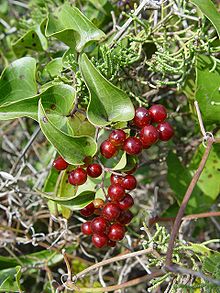Smilax
| Smilax | |
|---|---|
 |
|
| Mediterranean smilax (S. aspera) in fruit | |
| Scientific classification | |
| Kingdom: | Plantae |
| (unranked): | Angiosperms |
| (unranked): | Monocots |
| Order: | Liliales |
| Family: | Smilacaceae |
| Genus: |
Smilax L. |
| Species | |
|
Some 300–350, see text |
|
| Synonyms | |
|
|
Some 300–350, see text
Smilax is a genus of about 300–350 species, found in the tropics and subtropics worldwide. In China for example about 80 are found (39 of which are endemic), while there are 20 in North America north of Mexico. They are climbing flowering plants, many of which are woody and/or thorny, in the monocotyledon family Smilacaceae, native throughout the tropical and subtropical regions of the world. Common names include catbriers, greenbriers, prickly-ivys and smilaxes. "Sarsaparilla" (also zarzaparrilla, sarsparilla) is a name used specifically for the Jamaican S. regelii as well as a catch-all term in particular for American species. Occasionally, the non-woody species such as the smooth herbaceous greenbrier (S. herbacea) are separated as genus Nemexia; they are commonly known by the rather ambiguous name "carrion flowers".
Greenbriers get their scientific name from the Greek myth of Crocus and the nymph Smilax. Though this myth has numerous forms, it always centers around the unfulfilled and tragic love of a mortal man who is turned into a flower, and a woodland nymph who is transformed into a brambly vine.
On their own, Smilax plants will grow as shrubs, forming dense impenetrable thickets. They will also grow over trees and other plants up to 10 m high, their hooked thorns allowing them to hang onto and scramble over branches. The genus includes both deciduous and evergreen species. The leaves are heart shaped and vary from 4–30 cm long in different species.
...
Wikipedia
